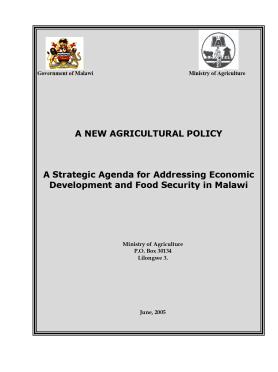New Agriculture Policy- A Strategic Agenda for Addressing Economic Development and Food Security in Malawi 2005
New Agriculture Policy- A Strategic Agenda for Addressing Economic Development and Food Security in Malawi 2005
Agriculture is the mainstay of the economy in Malawi. The sector contributes about 36% of the Gross Domestic Product (GDP), 87% of the total employment, supplies more than 65% of the manufacturing sector’s raw materials, provides 64% of the total income of the rural people, and contributes more than 90% of the foreign exchange earnings. It is the main livelihood of the majority of rural people, who account for more than 85% of the current estimated 12-13 million people.
Tobacco is the major export earner for Malawi contributing over 65 percent of the foreign exchange earnings although the crop is under threat through the Framework Convention on Tobacco Control (FCTC). Other important export commodities include tea and sugar, which respectively contribute about 10 and 11 percent. Maize is on the other hand, the major staple food crop with 60% of the total cropped land devoted to its production. Livestock contributes about 7% to GDP. The livestock enterprise is largely constituted by ruminants such as cattle, goats and sheep and monogastrics such as pigs and chickens. The livestock enterprise provides for both subsistence and commercial requirements
The evolution of the agriculture strategy in Malawi has been punctuated by a post-independence strategy which focused on parallel attainment of food self sufficiency through enhancement of the smallholder agriculture, and rapid economic growth through estate production with almost all major agricultural programmes, strategies and action
plans being guided by the food security policy.

